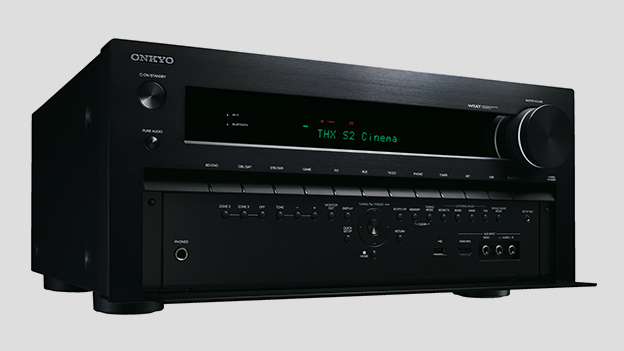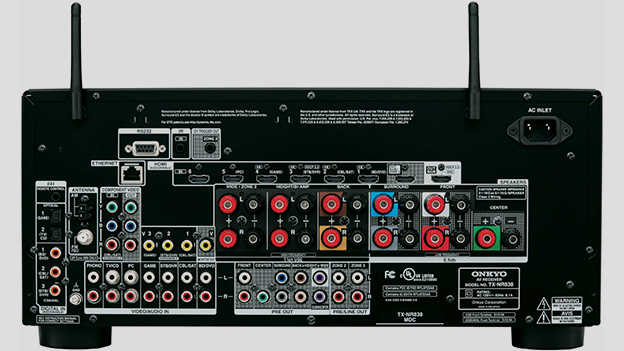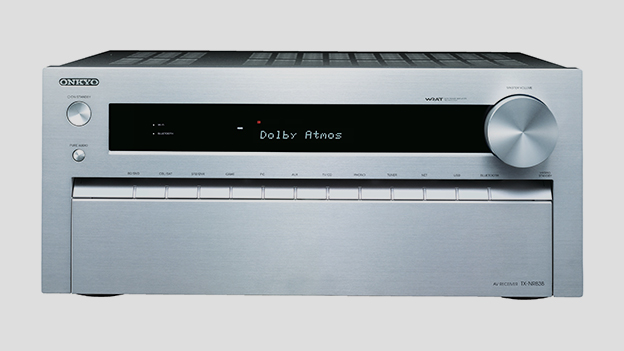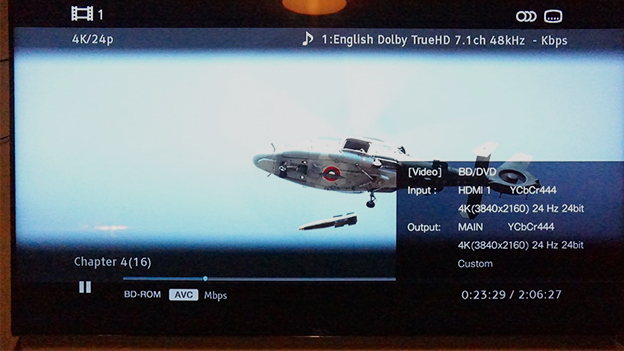Onkyo TX-NR838 review
Dolby Atmos lifts the THX-specified Onkyo TX-NR838 receiver to the next level


-
+
Comprehensive connectivity
-
+
Wide format compatibility
-
+
Ace sound from all 7 channels
-
-
Auto setup is not foolproof
-
-
7.1.2 not possible
-
-
Auto setup is not foolproof
Why you can trust T3





Height, or hype? Onkyo's THX-specified home cinema heavyweight is among the first to implement Dolby Atmos, but is it worth the extra speakers? Find out in our Onkyo TX-NR838 review.
Need an excuse to upgrade your AV receiver? Dolby Atmos could be the audio format that gives your home cinema the lift you were looking for and with two outputs for additional 'height' Atmos speakers the Onkyo TX-NR838 is one of the first to deliver Dolby's object-based surround sound. We wired the T3 test room for 5.1.2 sound and tracked down some Dolby Atmos soundtracks, to find out how Onkyo's receiver handled the overhead channels.
At £1,000, this THX Select heavyweight is leading the charge for Dolby Atmos, but you can also spot Atmos logos on the more affordable £500 Onkyo TX-NR636 and £800 Denon AVR-X4100W and of course the uncompromising Marantz SR7009 at £2,000.
Onkyo TX-NR838: Size and build
Anyone that judges an AV receiver by its bulk, will be impressed by the Onkyo TX-NR838. Standing almost 20cm high, 40cm deep and weighing 15.5kg, it's a beast and a handsome one at that. Available in either black, or silver, the crisp symmetry and heavy metal construction inspire confidence.
By contrast, the remote control is surprisingly small with some quite fiddly buttons and few shortcut buttons. We found that the Onkyo remote app ran very well on a smartphone though.
Onkyo TX-NR838: Features
Buying an AV receiver usually begins by checking off the features you know want from ever-growing lists and Onkyo has done well to keep up with the latest audio formats and HDMI updates. Every feature you can reasonably expect to find on a seven-channel receiver is present here. And with four HDMI 2.0 ports able to pass 3D, 4K and HDCP2.2 protected video together with uncompressed multichannel audio, you can feel fairly well future-proofed too.
We had no problem playing DSD music via SACD and high-resolution audio files such as FLAC and ALAC via the USB input. In fact, all of the current audio formats from Dolby TruHD to DTS-HD High Resolution Audio are covered and given that Dolby Atmos decoding arrived in the form of a firmware update through the Ethernet port, we would expect no less of DTS:X when that rival object-based surround format arrives.
Get all the latest news, reviews, deals and buying guides on gorgeous tech, home and active products from the T3 experts
A prominent Spotify sticker on the front panel indicates that you can also stream directly from the cloud-based music service, once you have established a connection using your smartphone.
Onkyo TX-NR838: Connections
Connectivity is king when you're swapping in a new AV receiver, so the sheer wall of inputs and outputs on offer here is reassuring. In addition to the four HDMI 2.0 inputs are two more HDMI 1.4 inputs and two outputs. There are five digital audio inputs and inputs for component and composite video sources. There's even a phono input for a turntable. The USB 3.0 port is a good way of inputting high-resolution audio files directly, but you can also stream music wireless via Bluetooth or wi-fi.
To cater for Dolby Atmos, there are two more pairs of speaker terminals than usual. Connect Atmos speakers to both the High and the Wide outputs and you'll be listening in 5.1.4 Atmos mode.
We chose to connect our existing 7.1 speakers and then add one pair of High Atmos speakers in order to toggle between regular 7.1 and Atmos-flavoured 5.1.2. Don't worry, you don't need to reconfigure your speakers each time you do this. If you were hoping to use all of the speaker outputs simultaneously for 7.1.2 sound, you'll need to look for a nine-channel receiver like Onkyo's step-up TX-NR1030 instead.
Without trying to turn this into a maths lesson, it's worth pointing out that there are not one, but two subwoofer pre-outputs, making 7.2, or 5.2.2 configurations possible.
Onkyo TX-NR838: set-up:
With all the extra speakers, the setup procedure could prove to be a headache, but it's not thanks to the bundled auto calibration system. Connect this mic and place it in your favourite listening position and the big Onk switches into setup mode ready to emit test signals through all of your connected speakers. After anyalysing the bursts of white noise it eventually sets the delay times and sound levels for you.
Onkyo's AccuEQ system (replacing the old Audyssey calibration) is clever, but it cannot correct badly placed Atmos speakers and it took us a few goes to achieve the desired Atmos effect. We used a pair of Onkyo SKH-410 Dolby Atmos-enabled add-on speaker modules balanced on top of the main front speakers in the end. Their upward angled drive units bounce the signal off the ceiling to provide the overhead illusion. The flimsy MDF cabinets with their fixed nylon grills stretched like tights over the drive units, look pretty crummy, but they did have the desired effect.
Onkyo TX-NR838: Audio quality
In Dolby Atmos mode, the Onkyo TX-NR838 demonstrates rather well, why you might go to the expense and inconvenience of filling your living room with yet more speakers. With The Expendables 3 as a test disc (there's not much Atmos software to choose from yet) and the Onkyo in 5.1.2 configuration, all seven channels work together to deliver an even more cohesive soundstage than usual. The energetic film soundtrack gives all seven speakers plenty to do and there's no shortage of scenes where Dolby's favourite surround sound vehicle, the helicopter, show off your new 'height' effect channels.
Unlike 7.1 setups, where the chopper appears to pass quickly through the room from your front speakers, to the rears and then surround backs, in Atmos mode, there's a long moment when the blades are thrashing somewhere overhead. And when you finally have your speakers positioned to hear this effect properly, it's really quite exciting and very much like the soundfield of a proper cinema. Our only regret here, is that you are faced with the stark choice between 7.1 and 5.1.2. It would have been nice to have the helicopter pass over and then fade into the surround backs as it did in the cinema, but as mentioned, you need nine channels to achieve that, not seven.
What the Atmos processing can also do for you is upmix 5.1 mixes into Atmos mode and add some overhead noise. It might help you to feel like you're getting your money's worth while you wait for real Atmos soundtracks to appear, but we weren't convinced that it's really improving the mix.
As a stereo, or regular surround sound receiver, the Onkyo TX-NR838 is just as accomplished. The powerful amplification makes it possible to drive quite large speakers with relative ease, so it always feels like you have plenty of headroom when you feel like turning up the volume. There's a propensity for slightly overwhelming bass, but there's nothing to stop you simply turning down the subwoofer a little after calibration.
Onkyo TX-NR838: Verdict
Even if you think you're not interested in Dolby Atmos now, it would be unwise to buy an AV receiver without the capability because it's likely to become a home cinema staple soon enough. If you are already set on Atmos however, you should consider stretching your budget to a nine-channel receiver so you don't have to give up your surround backs in Atmos mode. But even without the overhead speakers this receiver strikes what seems like the perfect balance between functionality, quality and value. It's not cheap, but you'll have seven amplifiers and all of the latest sound formats covered – for now anyway.
Onkyo TX-NR838 release date: Out now
Onkyo TX-NR838 price: £1,000